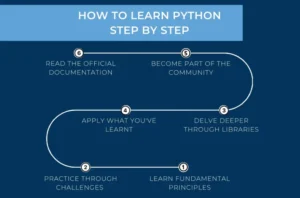How to Learn Python for Beginners: A Step-by-Step Guide in 2025
Python is one of the most popular programming languages in the world, and for good reason. It’s beginner-friendly, versatile, and used in fields like web development, data science, artificial intelligence, and more. If you’re wondering how to learn Python for beginners, you’ve come to the right place. This guide will walk you through everything you need to know to get started with Python in 2025.

Why Learn Python?
Before diving into the steps, let’s talk about why Python is worth learning:
- Easy to Learn: Python’s syntax is simple and readable, making it perfect for beginners.
- High Demand: Python developers are in high demand, with lucrative job opportunities.
- Versatility: From building websites to analyzing data, Python can do it all.
- Strong Community: Python has a massive community, so help is always available.
Step-by-Step Guide to Learning Python for Beginners
1. Understand the Basics
Start with the fundamentals of Python. Learn about:
- Variables and data types
- Conditional statements (if, else, elif)
- Loops (for, while)
- Functions and modules
Recommended Resource: FreeCodeCamp’s Python for Beginners course on YouTube.
2. Install Python and Set Up Your Environment
- Download Python from the official Python website.
- Install an Integrated Development Environment (IDE) like PyCharm, VS Code, or Jupyter Notebook.
- Practice writing and running simple scripts.
3. Practice Coding Daily
Consistency is key when learning Python. Dedicate at least 30 minutes a day to coding. Use platforms like:
- LeetCode: For coding challenges.
- HackerRank: For beginner-friendly exercises.
- Codewars: To solve problems and improve your skills.
4. Work on Mini-Projects
Apply what you’ve learned by building small projects. Here are some ideas:
- A calculator app
- A to-do list manager
- A number guessing game
- A weather app using an API
5. Learn Python Libraries and Frameworks
Python’s power lies in its libraries. Explore:
- NumPy and Pandas for data analysis.
- Matplotlib and Seaborn for data visualization.
- Flask or Django for web development.
- TensorFlow or PyTorch for machine learning.
6. Join the Python Community
Engage with other learners and experts:
- Join forums like Reddit’s r/learnpython.
- Participate in Python communities on Stack Overflow.
- Attend local or virtual Python meetups.
7. Build a Portfolio
Showcase your skills by creating a portfolio. Include:
- Your projects
- Code snippets
- Links to your GitHub repository
FAQs About Learning Python
1. How long does it take to learn Python for beginners?
It depends on your dedication. With consistent practice, you can learn the basics in 2-3 months. Mastery may take 6-12 months.
2. Can I learn Python without any programming experience?
Absolutely! Python is one of the best languages for beginners with no prior coding experience.
3. Is Python enough to get a job?
Yes, Python is highly sought after in fields like data science, web development, and automation. However, complement it with other skills like SQL or machine learning for better opportunities.
4. What are the best free resources to learn Python?
- FreeCodeCamp (YouTube)
- Python.org (Official Documentation)
- W3Schools (Tutorials)
- Real Python (Blog and Tutorials)
5. Should I learn Python 2 or Python 3?
Always learn Python 3, as Python 2 is no longer supported.
Conclusion
Learning Python as a beginner doesn’t have to be overwhelming. By following this step-by-step guide, practicing consistently, and leveraging the right resources, you’ll be writing Python code in no time. Whether you’re aiming for a career in tech or just want to learn a new skill, Python is a great place to start.
So, what are you waiting for? Start your Python journey today and unlock endless possibilities!
Call to Action:
If you found this guide helpful, share it with others who want to learn Python. And don’t forget to leave a comment below with your favorite Python learning resource! 🚀

